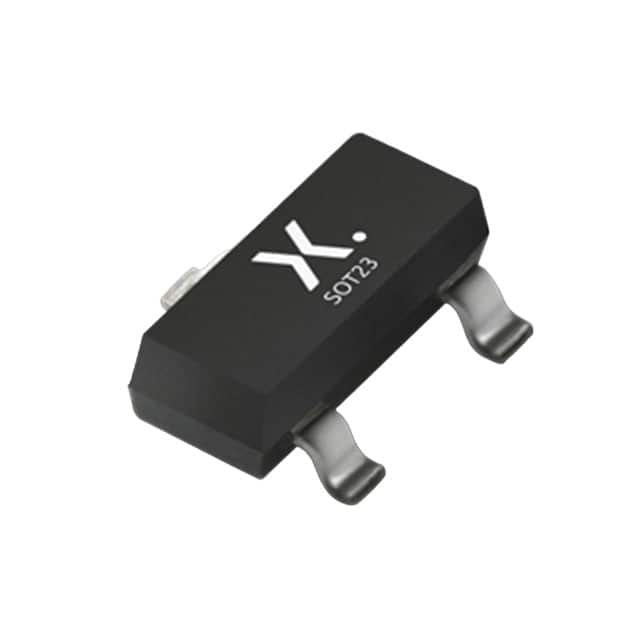Viz Specifikace pro podrobnosti o produktu.

PMBTA13,215
Introduction
PMBTA13,215 is a bipolar PNP transistor belonging to the category of electronic components. This entry provides an overview of its basic information, specifications, pin configuration, functional features, advantages and disadvantages, working principles, application field plans, and alternative models.
Basic Information Overview
- Category: Electronic Component
- Use: Amplification and Switching
- Characteristics: High voltage capability, low collector-emitter saturation voltage
- Package: SOT-23
- Essence: Bipolar PNP Transistor
- Packaging/Quantity: Tape & Reel, 3000 units per reel
Specifications
- Collector-Emitter Voltage (VCEO): -50V
- Collector-Base Voltage (VCBO): -50V
- Emitter-Base Voltage (VEBO): -5V
- Collector Current (IC): -100mA
- Power Dissipation (PD): 225mW
- Transition Frequency (fT): 250MHz
- Operating Temperature Range: -55°C to +150°C
Detailed Pin Configuration
- Emitter (E)
- Base (B)
- Collector (C)
Functional Features
- High voltage capability
- Low collector-emitter saturation voltage
- Fast switching speed
- Suitable for audio amplification and small signal switching applications
Advantages and Disadvantages
Advantages
- High voltage capability allows for versatile use in various electronic circuits
- Low collector-emitter saturation voltage reduces power dissipation and enhances efficiency
- Fast switching speed enables quick response in switching applications
Disadvantages
- Limited collector current may not be suitable for high-power applications
- Sensitive to temperature variations due to its operating temperature range
Working Principles
PMBTA13,215 operates based on the principles of bipolar junction transistors, utilizing the flow of charge carriers to amplify or switch electronic signals. When a small current flows into the base terminal, it controls a larger current between the collector and emitter terminals, enabling amplification or switching functions.
Detailed Application Field Plans
PMBTA13,215 finds extensive use in the following application fields: - Audio Amplification Circuits - Signal Switching Circuits - Sensor Interface Circuits - Oscillator Circuits - Voltage Regulator Circuits
Detailed and Complete Alternative Models
- BC557: Similar PNP transistor with comparable characteristics
- 2N3906: PNP transistor suitable for general-purpose amplification and switching
- MPSA92: High-voltage PNP transistor with fast switching speed
In conclusion, PMBTA13,215 is a versatile bipolar PNP transistor with high voltage capability and low collector-emitter saturation voltage, making it suitable for various amplification and switching applications across different electronic circuits.
[Word Count: 398]
Seznam 10 běžných otázek a odpovědí souvisejících s aplikací PMBTA13,215 v technických řešeních
What is PMBTA13,215?
- PMBTA13,215 is a high-performance NPN bipolar junction transistor (BJT) commonly used in electronic circuits for amplification and switching applications.
What are the key specifications of PMBTA13,215?
- The key specifications of PMBTA13,215 include a maximum collector current (Ic) of 100mA, a maximum collector-base voltage (Vcbo) of 30V, and a maximum transition frequency (ft) of 250MHz.
How can PMBTA13,215 be used in amplifier circuits?
- PMBTA13,215 can be used as a small-signal amplifier in audio and radio frequency (RF) circuits due to its high transition frequency and low noise characteristics.
In what types of switching applications can PMBTA13,215 be utilized?
- PMBTA13,215 is suitable for low-power switching applications such as signal routing, level shifting, and digital logic interfacing.
What are the typical operating conditions for PMBTA13,215?
- The typical operating conditions for PMBTA13,215 include a collector current (Ic) of 10-50mA, a collector-emitter voltage (Vce) of 5-15V, and a base current (Ib) of 1-5mA.
Can PMBTA13,215 be used in high-frequency applications?
- Yes, PMBTA13,215's high transition frequency makes it suitable for high-frequency applications such as RF amplifiers and oscillators.
What are the thermal considerations when using PMBTA13,215 in technical solutions?
- It is important to consider proper heat sinking and thermal management to ensure that PMBTA13,215 operates within its specified temperature range for reliable performance.
Are there any specific layout considerations for incorporating PMBTA13,215 in PCB designs?
- Proper grounding, decoupling, and trace routing techniques should be employed to minimize parasitic effects and ensure stable operation of PMBTA13,215 in PCB layouts.
What are the alternatives to PMBTA13,215 for similar technical applications?
- Alternatives to PMBTA13,215 include other NPN transistors with comparable specifications such as BC547, 2N3904, and 2SC945.
Where can I find detailed application notes and reference designs for utilizing PMBTA13,215 in technical solutions?
- Detailed application notes and reference designs for PMBTA13,215 can be found on the manufacturer's website, in technical datasheets, and in relevant electronics engineering literature.

